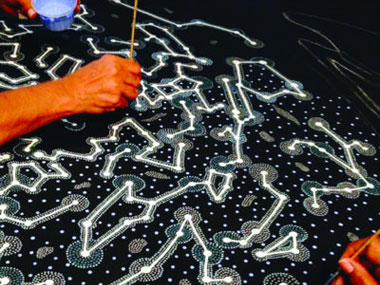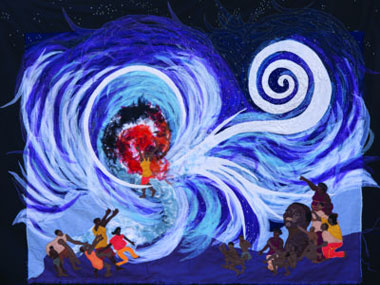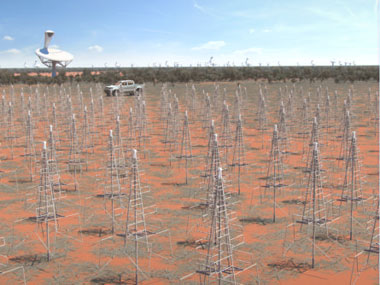REACHING FOR THE STARS IN WA

Collaborative painting, acrylic on canvas, Yamaji Art.
Posted by Jeremy Eccles | 30.10.14
A collaborative exhibition by artists from Australia and South Africa, exploring the skies as seen through the Square Kilometre Array (SKA) radio telescope project, is currently on at Curtin University’s John Curtin Gallery, and will later tour internationally. Yamaji and other Aboriginal artists from the Mid-West region of Western Australia and African artists of San descent and others from the central Karoo region of South Africa have created artworks in response to ancestral stories about the night sky – a sky they both share as it appears above their own traditional homelands.
Hence the name, 'Shared Sky'.
These sparsely populated, remote areas were specifically chosen for the SKA because of their radio quietness and isolation, making them the perfect sites to co-develop the SKA – the world’s largest radio telescope – itself a collaboration between governments, scientists and engineers from around the world.
They are also both sites of rich and ancient traditions that have largely disappeared from view in their ancestral lands but live on strongly in the spirit of the artists working in the community-based art centres of Nieu Bethesda in South Africa and Geraldton and Mullewa in Western Australia.
Australian Square Kilometre Array Director, Professor Brian Boyle said this art project reflected the collaborative nature of the SKA project itself. “These are two very different locations, half a world apart, connected by a shared night sky, who will soon share the world’s largest telescope too,” Professor Boyle said. “Now is a great time to take stock and look back on the history and cultural understanding of the night sky, as well as look forward to developing more understanding about that sky and the history of the Universe than ever before.”
John Curtin Gallery Director Chris Malcolm said this exhibition was an opportunity for these artists to come together and share their own stories. “This exhibition is all about learning from each other and celebrating the differences and embracing the common ancestry that links us all when we gaze upon the Shared Sky,” Mr Malcom said. “Ancient creation stories handed down through oral traditions over thousands of years in both continents are reflected in the moving vista of the Milky Way that is depicted in many artworks from both Africa and Australia.”
Shared Sky runs at the John Curtin Gallery only until 2 November 2014, before touring SKA-member countries around the world. Australia will host two elements of the SKA telescope, a low frequency array and a survey array. South Africa will host the mid-frequency aperture array antennas. Two precursor telescopes are already built at Australia’s SKA site, the Murchison Widefield Array (an international project led by the Curtin Institute of Radio Astronomy (CIRA) at Curtin University), and CSIRO’s Australian SKA Pathfinder telescope. South Africa is already host to KAT7 telescope array, an important testing ground for initially the MeerKAT telescope array, a 64 dish system which will form a precursor to the full SKA Telescope.
URL: http://news.curtin.edu.au
Share this:
»  del.icio.us
»
del.icio.us
»  Digg it
»
Digg it
»  reddit
»
reddit
»  Google
»
Google
»  StumbleUpon
»
StumbleUpon
»  Technorati
»
Technorati
»  Facebook
Facebook
Contact Details

'The Girl who made the Stars', collaborative art quilt, First People Artists, Bethesda Arts Centre.

What the SKA project looks like in remote WA
Further Research
News Tags: Curtin University | Jeremy Eccles | San art | SKA | Yamaji art
News Categories: Australia | Blog | Europe | Exhibition | News | North America
Exhibition Archive
- 10.10.17 | TARNANTHI 2017
- 11.08.17 | Natsiaas 2017
- 20.07.17 | APY ART DOMINATES THE WYNNE
- 17.07.17 | Anangu Artist Wins $100,000 Prize
- 14.07.17 | The End of AAMU
- 11.07.17 | ART ACROSS THE COUNTRY
- 11.07.17 | TARNANTHI IN OCTOBER
- 05.07.17 | TJUNGUṈUTJA - from having come together
- 13.06.17 | Ghost-Nets Straddle the World
- 07.06.17 | Grayson Perry Going Indigenous?
- 05.06.17 | Barks Bigger than Ben Hur
- 27.05.17 | NGA QUINQUENNIAL 2017
- 21.05.17 | Blak Douglas Finds Home at the NGA
- 21.05.17 | BRIAN ROBINSON WINS HAZELHURST WOP
- 18.05.17 | PARRTJIMA 2.0
Advertising

